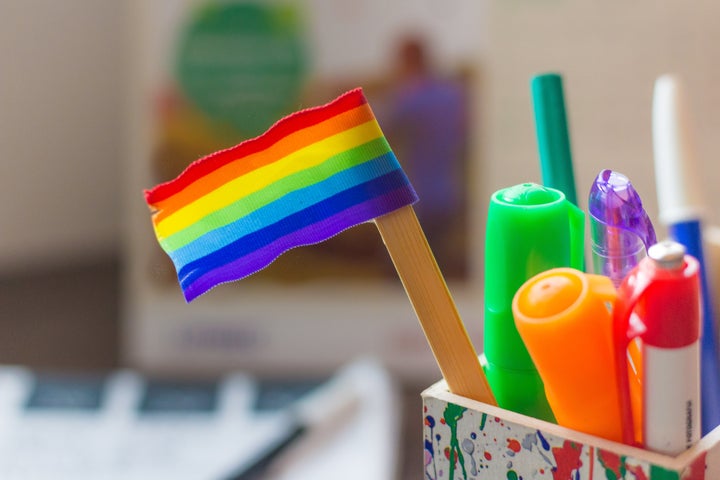
Growing up, I was fortunate to learn about the rich history of men and women who made a difference in the world throughout the centuries. My school made sure to teach us about extraordinary women like Sally Ride, Florence Nightingale and Eleanor Roosevelt. I lived in Prince George’s County, a predominantly black area of Maryland, so I was lucky to learn about inspiring figures like Martin Luther King Jr., Malcolm X, Sojourner Truth and more in my formative years.
Unfortunately in the 1990s, when I grew up, American society was just starting to get the message that being gay was OK, so none of my teachers acknowledged LGBTQ history. It wasn’t until I was 16 years old, working part time at a public library and doing my own research that I found out writers like Langston Hughes, Walt Whitman and James Baldwin were gay. I had learned much about them in my English classes, but I guess my teachers decided to skip that detail.
LGBTQ people have existed throughout history and made tremendous contributions to American culture, yet no one talked about them in school, and there were hardly any books available highlighting the brave queer and trans people who paved the way for the rest of us. If I had known about them, I might not have suffered through years of alienation, confusion and self-hatred. I would have learned to love and embrace my true self sooner.
“LGBTQ people have existed throughout history and made tremendous contributions to American culture, yet no one talked about them in school.”
Even the public library where I worked at had a very limited selection of LGBTQ-related books, and what few books it carried about the subject were essentially unclear about how to describe homosexuality: Is it a sin? Is it a choice? Do gay men want to be women? While I’m glad my library had these books at all, they didn’t really help me, because I wasn’t gay; I was a bisexual nonbinary transgender kid, and we didn’t exist in the general LGBTQ discourse at the time.
Nothing in the books I was able to get my hands on suggested that sexuality and gender could be fluid and that there was a place for people like me. Sure, some of those early LGBTQ 101 books briefly mentioned the B and the T, but bisexuality was portrayed as only half-gay, and transgender meant only binary trans women and didn’t mention trans men at all. As a result, I spent the next 13 years believing I was just a really confused straight man. All I needed to do was find a good conservative Christian woman to marry, and then I’d be fine.
After a six-year relationship with one such good conservative Christian woman — three good years and three bad years — I finally decided to research bisexuality on the Internet and realized I was queer enough to come out. I still struggled with validating my identity, though, so I started a Tumblr account and introduced myself to a wonderful community of bisexuals who shared the frustrations I had. Not only did I find bisexual validation through Tumblr, but I also both discovered that nonbinary was a thing and found the LGBTQ historical heroes I desperately needed when I was younger.
For starters, it was only a few years ago that I learned about a bisexual polyamorous kinky feminist known as Brenda Howard, the “Mother of Pride,” a primary organizer of the Christopher Street Liberation Day March in New York City in 1970 — one of the first LGBTQ pride parades — and she came up with idea of a weeklong celebration around Pride Day, which has evolved into the Pride Month we’re currently celebrating. So for gays and lesbians who think bisexuals aren’t part of the LGBTQ community, they have a bisexual to thank for Pride.
Another LGBTQ hero I wish I knew about earlier was Leslie Feinberg, who in an interview expanded the definition of the word “transgender” to mean “people who have crossed the boundaries of sex or gender assumptions that you’re assigned at birth, whether that be transsexual women and men or masculine women or feminine men … It can mean everyone who doesn’t fit that ’Ozzie and Harriet’ paradigm of sex and gender.” Feinberg defied the gender binary, identifying as transgender and a butch lesbian, and used “ze”/“hir” pronouns as well as the standard “she”/“her” pronouns. If countless nonbinary kids like me had known about Feinberg, it would have given us the language we desperately needed to define ourselves.
Fortunately, things are starting to change. In May the Illinois Senate passed a bill that would require lesbian, gay, bisexual and transgender history to be taught in public schools. According to the Columbia Chronicle, Senate Bill 3249 would require school curriculums to include classes that “would teach historical contributions of LGBT people in the U.S. and Illinois and require textbooks that accurately portray diversity in society.” The bill now awaits the House’s vote.
“Learning LGBTQ history would help destigmatize queer and trans people for cisgender straight kids.”
Naturally, the idea of teaching LGBTQ history to children doesn’t sit well with right-wing Christians. For example, Ralph Rivera of the conservative group the Illinois Family Institute told the Chicago Tribune, “Where’s the protection for students and parents who have a religious belief?” To which the Chicago Sun-Times responded in an editorial, “Acknowledging that a person of historical significance was gay, lesbian, transgender or bisexual makes no value judgment except to say the person existed and made contributions. These are historical facts. Teachers have an obligation to tell history accurately. That’s what schools are supposed to do.”
I don’t live in Illinois, so my two cents about the bill don’t mean much to the state’s legislators. However, I hope the bill passes the House so young LGBTQ kids won’t have as difficult of a time learning about their culture and coming out as I did. They would be able to see themselves in the people like Sylvia Rivera, Harvey Milk, Marsha P. Johnson, Feinberg, Howard and countless others who stood up for their rights to exist and define themselves.
Not only that, but learning about LGBTQ history would help destigmatize queer and trans people for cisgender straight kids. Just as learning about Sojourner Truth and Frederick Douglass helped shaped my views on feminism and racial justice as a white person, being taught LGBTQ history could help prepare today’s cis straight youths to fight future injustices against queer and trans people. In the end, LGBTQ history lessons benefit everyone, regardless of sexual orientation or gender identity.
According to the Public Religion Research Institute, 7 percent of young people surveyed said they identify on the LGBTQ spectrum, and the number of LGBTQ-identified youths is expected to grow. We owe it to these young people to teach them about one of the fastest-growing cultures and all that they have to offer society. While I’m glad I finally found a rich history of LGBTQ heroes who weren’t white, cis or gay men and women, I still wish I had discovered them when I was younger and needed to know about them the most. Hopefully, more initiatives like Illinois’ Senate Bill 3249 will follow and will allow young queer and trans kids to see themselves represented as important historical figures, and they’ll feel pride early on in their lives.
Trav Mamone is a bisexual genderqueer (“they”/“them”) writer based in Maryland who focuses on the intersections of social justice and secular humanism. They also host the “Bi Any Means” podcast and co-host the “Biskeptical” podcast.
#TheFutureIsQueer is HuffPost’s monthlong celebration of queerness, not just as an identity but as action in the world. Find all of our Pride Month coverage here.
